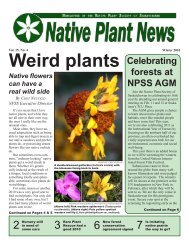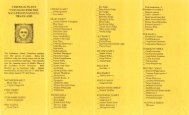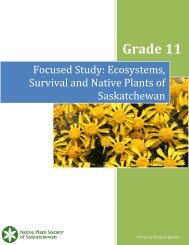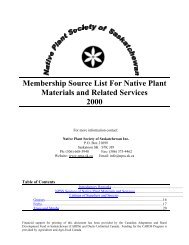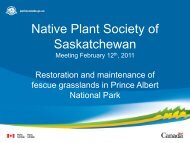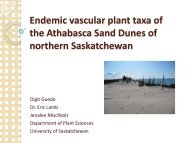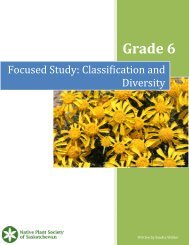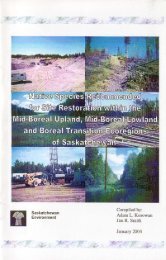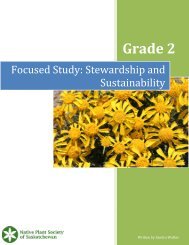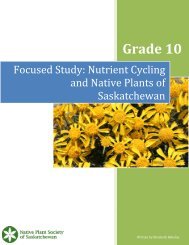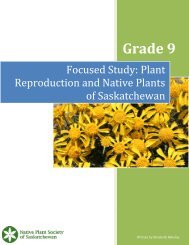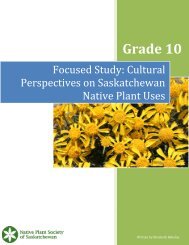Saskatchewan Guidelines For Use Of Native Plants In Roadside ...
Saskatchewan Guidelines For Use Of Native Plants In Roadside ...
Saskatchewan Guidelines For Use Of Native Plants In Roadside ...
Create successful ePaper yourself
Turn your PDF publications into a flip-book with our unique Google optimized e-Paper software.
<strong>Saskatchewan</strong> <strong>Guidelines</strong> <strong>For</strong> <strong>Use</strong> <strong>Of</strong> <strong>Native</strong> <strong>Plants</strong> <strong>In</strong> <strong>Roadside</strong> Revegetation<br />
Field Guide<br />
replaced onto the site if it is certain that the topsoil is noxious weed free after treatment.<br />
If the topsoil is not free of the vast majority of noxious weeds, the topsoil should not be<br />
used. If the topsoil contaminated with noxious weed seeds was replaced accidentally or<br />
absolutely must be replaced for some reason, seeding these sites to non-aggressive tame<br />
grasses is recommended. Storing topsoil for prolonged periods should be avoided in<br />
order to keep beneficial fungi and any native seed bank viable. When storing topsoil,<br />
wide and shallow rows should be chosen over deep and narrow piles, as the former is<br />
more beneficial to the survival of any beneficial fungi and/or native seed bank.<br />
A. Erosion<br />
If erosion is a concern, there are many pre-emptive measures that can be used<br />
effectively.<br />
1. Straw crimping – working straw into the soil either before or after<br />
seeding using a straw crimper.<br />
2. <strong>In</strong>cluding rhizomatous species in the seed mix (all of the recommended<br />
seed mixes contain at least one rhizomatous species).<br />
3. Using permeable erosion barriers such as straw matting, coir (coconut<br />
fibre) matting, or a combination of both directly on the soil surface.<br />
4. Spraying the surface with tactifier (a glue-like substance).<br />
5. Revegetating the area with methods better suited to preventing erosion,<br />
such as laying sod, native hay mulching or hydro-seeding.<br />
6. Using various seeding techniques that prevent erosion, like crossseeding<br />
(single passes seeded at right angles to each other) and using a<br />
higher seeding rate.<br />
If watercourses or drainage features are present on the site, other techniques also<br />
exist.<br />
1. Silt fencing – constructing fences out of wooden/metal stakes and<br />
geotextile fabric, placed perpendicular to any slope.<br />
2. Straw rolls – rolling straw or coir matting and pegging it to the surface<br />
perpendicular to the slope.<br />
3. Armouring – placing stones, gravel, concrete rubble or any coarse,<br />
heavy material on surfaces that will be exposed to water scour. Geotextile<br />
fabric also works, although not as well.<br />
Figure 2. Erosion control at<br />
Beaver Creek Conservation<br />
Area after construction on<br />
highway 219. Many different<br />
techniques are being used<br />
here, including armouring a<br />
drainage channel with<br />
interlocking concrete blocks<br />
(bottom left), armouring a scour<br />
area with rock (top center),<br />
installing silt fences along a<br />
watercourse (right center),<br />
placing geotextile fabric on<br />
slopes (right center) and<br />
securing straw matting with<br />
straw rolls on slopes (left



